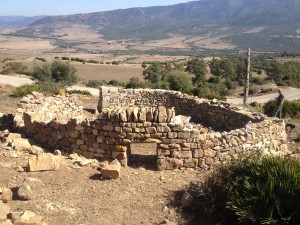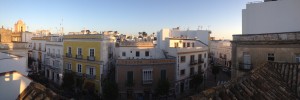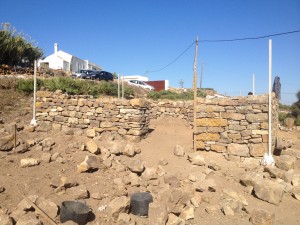Leonardo Lifelong learning Dry Stone Walling project – Spain 2013
I was fortunate to be selected as one of the British wallers to be offered a place on an EU funded cultural exchange programme, called Leonardo. The DSWA has been working with partner organisations in Spain, Italy and France for a couple of years putting together a programme of dry stone walling based reciprocal visits. In early October, it was the turn of Spain to host wallers and stone interested people from the other partner countries. So, myself, Alison Shaw from DSWA HQ, and six other professional wallers headed to the sun of Andalucía.
We spent a fascinating evening walking around the streets of Seville on the first evening, in the company of our host Alberto. It’s a beautiful city and the area around the cathedral doubly so. One of the most interesting aspects of the trip was the language barriers that existed between the different nationalities. Alberto is a very enthusiastic Spaniard who speaks his own language very well, but unfortunately English not so well. Our Spanish was limited to asking for beer. So, I’m not so sure what he told us about the cathedral, but I am sure it was interesting…
One thing that was clear from early on in the trip was that we would be fed very well. From arriving in Seville, we were put on a strict regime of eating, eating and more eating.
Day 1 proper and we had a presentation from various parties, including all four partner organisations. It was clear that the Leonardo project was a lot bigger than I had assumed – there are many organisations involved in Spain, and the Spanish have set themselves a wide ranging remit of raising the profile of the heritage of stone structures within the Andalucian countryside.
Later in the day the whole party drove a couple of hours further north to the town of Constantina, which is where we were based for the next couple of days. In the two days in Constantina, we were shown point of interest, including an amazing karst landscape that had formerly been an iron ore quarry that was interestingly set up by Scottish engineers in the 19th Century. I brought a small piece of iron ore home with me – it is so dense and heavy for such a small stone.
On the Tuesday afternoon, we shifted location to the south coast, moving to Tarifa. Situated an hour west of Gibraltar, Tarifa is pretty much the closest bit of Spain to North Africa. Finally, we would get to build something. But only after another massive dinner.
Building began on Wednesday, with a basic plan of getting two stone structures created over three days. Although there were nearly forty wallers, it became clear over the next day or so that the British and some of the French were the only professional stone workers. Most of the Italians were rangers or workers from their national parks, and although they did some stone repair work, walling was not their full-time job. The French were a mix of trainers and trainees embarked on their walling training programme. All of the Spanish wallers were amateurs.
I had hoped to learn something of the techniques used by partner nations, but I was to be disappointed in this. We tended to work in our own separate groups; and although it was interesting watching how others worked, it was clear early on that the Brits had the better technique, organisation and work ethic. Basically, we worked harder, faster and longer.
The stone was a mix of sandstone and limestone. We had 20 tonnes delivered prior to starting work, and when on day two of building, we started to run out, I was one of several people volunteered to get more. We drove back along the access the road for a bit, and then struck up the hillside. Basically, the stone was all around us, and we just had to pick it up and move it to a waiting truck. It’s a very old fashioned method, and novel to someone like me who is used to getting deliveries of stone for my work! Making it even more fun was being told to check for scorpions under the stones. Sure enough, the next stone I picked had a very annoyed looking scorpion, with poisonous tail raised and ready for action. The stone was replaced, and I moved on. As you can imagine, I was very careful after that!
Back at the work site, the two structures – a round sheep fold and a square building base – were progressing. The different groups worked according to their principles: the Italian’s “stole” all of the nicest stone (and later accused the Brits of doing just that!); the French were busy with their chisels; the Spanish seemed intent on just throwing their wall up; and the Brits were working methodically trying to keep batter, crossing joints, and stone running into the wall.
One of the downsides of the project was that it was only on the final day of the build that we all had a discussion about methods of working and building. There were some clear differences in style and even some lack of basic technical know-how amongst some of the group. With a mix of experience and nationalities, it was always going to be hard to organise the work.
Notwithstanding the issues from the dry stone walling work, the project was amazing. We all had a great time; everyone got on well; we were well fed and there was amble chance to socialise and use our best pidgin French/Spanish /Italian/Yorkshire.
Hopefully the initial set of visits will lead to the development of further ties with the partner countries. It would be beneficial from a professional point of view to be able to work abroad, and also to offer work to others too. And hopefully the project will strengthen ties amongst members in the UK too. Sometimes working away on your own in Scotland, you forget that there is a whole world of walling going on in other parts of the UK.





Pingback : Dry stone walling - review of 2013Stone Inspired
Hi I would be very interested in having an opportunity to drystone wall in Spain, any information, ie what it entails reading accommodation and living, working for my keep ? , kind regards
Hi Jonathan
I’m sorry but I don’t have any contacts in Spain to advise you to contact. The work experience/cultural visit I was on in 2013 was jointly organised by the dry stone walling groups in the UK, Spain, France and Italy. I was just one of the participants on one of the weeks.
If you’re interested in working in Spain, contact the Dry Stone Walling Association of GB, and they’ll be able to help. Or go onto one of the several DSW groups on Facebook and ask there.
Best of luck.
Jason